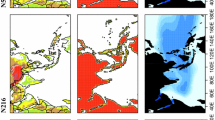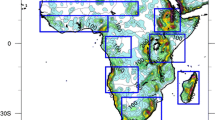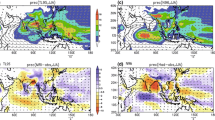Abstract
The sensitivity of the representation of the global monsoon annual cycle to horizontal resolution is compared in three AGCMs: the Met Office Unified Model-Global Atmosphere 3.0; the Meteorological Research Institute AGCM3; and the Global High Resolution AGCM from the Geophysical Fluid Dynamics Laboratory. For each model, we use two horizontal resolution configurations for the period 1998–2008. Increasing resolution consistently improves simulated precipitation and low-level circulation of the annual mean and the first two annual cycle modes, as measured by the pattern correlation coefficient and equitable threat score. Improvements in simulating the summer monsoon onset and withdrawal are region-dependent. No consistent response to resolution is found in simulating summer monsoon retreat. Regionally, increased resolution reduces the positive bias in simulated annual mean precipitation, the two annual-cycle modes over the West African monsoon and Northwestern Pacific monsoon. An overestimation of the solstitial mode and an underestimation of the equinoctial asymmetric mode of the East Asian monsoon are reduced in all high-resolution configurations. Systematic errors exist in lower-resolution models for simulating the onset and withdrawal of the summer monsoon. Higher resolution models consistently improve the early summer monsoon onset over East Asia and West Africa, but substantial differences exist in the responses over the Indian monsoon region, where biases differ across the three low-resolution AGCMs. This study demonstrates the importance of a multi-model comparison when examining the added value of resolution and the importance of model physical parameterizations for simulation of the Indian monsoon.
摘要
利用分别来自英国, 日本和美国的三个大气环流模式(AGCM): MetUM-GA3, MRI-AGCM和GFDL-HiRAM, 对比了水平分辨率提高对全球降水年循环模拟的影响. 通过对比分析1998-2008年3个AGCM不同分辨率模式模拟结果, 研究发现较之低分辨率版本, 高分辨率一致提高了低分辨率模式对年平均降水, 全球季风前两个年循环模态的降水和低层环流的模拟能力. 高分辨率对夏季风爆发和撤退时间的模拟的影响却具有区域依赖性, 高分辨率在三个AGCM对季风撤退时间模拟中的作用亦各不相同. 区域而言, 高分辨率一致减小了低分辨率模式中西非, 西北太平洋季风区年平均降水和前两个季风模态降水偏多的误差, 降低了东亚季风区的季风模态偏强, 春秋非对称模态偏弱的模拟偏差, 改善了三个AGCM中东亚和西非夏季风爆发偏早的误差. 然而在印度季风区, 不同低分辨率模式模拟的爆发时间偏差及其对高分辨率的响应均不相同. 因此, 本文表明有必要采用多模式比较的方法以明确高分辨率对模拟结果影响, 物理参数化过程对提升印度季风模拟能力至关重要.
Similar content being viewed by others
References
Adler, R. F., and Coauthors, 2003: The version-2 global precipitation climatology project (GPCP) monthly precipitation analysis (1979–present). Journal of Hydrometeorology, 4, 1147–1167, https://doi.org/10.1175/1525-7541(2003)004<1147:TVGPCP>2.0.CO;2.
Berckmans, J., T. Woollings, M.-E. Demory, P.-L. Vidale, and M. Roberts, 2013: Atmospheric blocking in a high resolution climate model: Influences of mean state, orography and eddy forcing. Atmospheric Science Letters, 14, 34–40, https://doi.org/10.1002/asl2.412.
Chen, J. H, and S. J. Lin, 2013: Seasonal predictions of tropical cyclones using a 25-km-resolution general circulation model. J. Climate, 26, 380–398, https://doi.org/10.1175/JCLI-D-12-00061.1.
Demory, M.-E., P. L. Vidale, M. J. Roberts, P. Berrisford, J. Strachan, R. Schiemann, and M. S. Mizielinski, 2014: The role of horizontal resolution in simulating drivers of the global hydrological cycle, Clim. Dyn., 42(7–8), 2201–2225.
Dong, G. T., H. Zhang, A. Moise, L. Hanson, P. Liang, and H. Ye, 2016: CMIP5 model-simulated onset, duration and intensity of the Asian summer monsoon in current and future climate. Climate Dyn., 46, 355–382, https://doi.org/10.1007/s00382-015-2588-z.
Donlon, C. J., M. Martin, J. Stark, J. Roberts-Jones, E. Fiedler, and W. Wimmer, 2012. The Operational Sea Surface Temperature and Sea Ice Analysis (OSTIA) system. Remote Sensing of Environment, 116, 140–158, https://doi.org/10.1016/j.rse.2010.10.017.
Endo, H., A. Kitoh, T. Ose, R. Mizuta, and S. Kusunoki, 2012: Future changes and uncertainties in Asian precipitation simulated by multiphysics and multi-sea surface temperature ensemble experiments with high-resolution Meteorological Research Institute atmospheric general circulation models (MRI-AGCMs). J. Geophys. Res., 117, D16118, https://doi.org/10.1029/2012JD017874.
Hack, J. J., J. M. Caron, G. Danabasoglu, K. W. Oleson, C. Bitz, and J. E. Truesdale, 2006: CCSM-CAM3 climate simulation sensitivity to changes in horizontal resolution, J. Climate, 19(11), 2267–2289.
Higgins, R. W., and W. Shi, 2001: Intercomparison of the principal modes of interannual and intraseasonal variability of the North American Monsoon System. J. Climate, 14, 403–417, https://doi.org/10.1175/1520-0442(2001)014<0403:IOTPMO>2.0.CO;2.
Huang, D. Q., J. Zhu, Y.-C. Zhang, and A.-N. Huang, 2013: Uncertainties on the simulated summer precipitation over eastern China from the CMIP5 models. J. Geophys. Res., 118, 9035–9047, https://doi.org/10.1002/jgrd.50695.
Huffman G. J., and Coauthors, 2007: The TRMM multisatellite precipitation analysis (TMPA): Quasi-global, multiyear, combined-sensor precipitation estimates at fine scales. Journal of Hydrometeorology, 8, 38–55, https://doi.org/10.1175/JHM560.1.
Hung, C.W., and M. Yanai, 2004: Factors contributing to the onset of Australian summer monsoon. Quart. J. Roy. Meteor. Soc., 130, 739–758, https://doi.org/10.1256/qj.02.191.
Johnson, S. J., and Coauthors, 2016: The resolution sensitivity of the South Asian monsoon and Indo-Pacific in a global 0. 35° AGCM. Climate Dyn., 46, 807–831, https://doi.org/10.1007/s00382-015-2614-1.
Jolliffe, I. T., and D. B. Stephenson, 2003: Forecast Verification: A Practitioner’s Guide in Atmospheric Science. Wiley, 240 pp.
Kalnay, E., and Coauthors, 1996: The NCEP/NCAR 40-Year Reanalysis Project. Bull. Amer. Meteor. Soc., 77, 437–472.
Kang, I.-S., 2004: Current status of AGCM monsoon simulations. East Asian Monsoon, C.-P. Chang, Ed., World Scientific, 301–331, https://doi.org/10.1142/97898127014110008.
Kitoh, A., and S. Kusunoki, 2008: East Asian summer monsoon simulation by a 20-km mesh AGCM. Climate Dyn., 31, 389–401, https://doi.org/10.1007/s00382-007-0285-2.
Krishnamurti, T. N., and Y. Ramanathan, 1982: Sensitivity of the monsoon onset to differential heating. J. Atmos. Sci., 39, 1290–1306, https://doi.org/10.1175/1520-0469(1982)039<1290:SOTMOT>2.0.CO;2.
Kusunoki, S., 2016: Is the global atmospheric model MRIAGCM3-2 better than the CMIP5 atmospheric models in simulating precipitation over East Asia? Climate Dyn., https://doi.org/10.1007/s00382-016-3335-9. (in Press)
Li, J., R. C. Yu, W. H. Yuan, H. M. Chen, W. Sun, and Y. Zhang., 2015: Precipitation over East Asia simulated by NCAR CAM5 at different horizontal resolutions. Journal of Advances in Modeling Earth Systems, 7, 774–790, https://doi.org/10.1002/2014MS000414.
Li, P. X., T. J. Zhou, and X. L. Chen, 2017: Water vapor transport for spring persistent rains over southeastern China based on five reanalysis datasets. Climate Dyn., https://doi.org/10.1007/s00382-017-3680-3. (in Press)
Liu, Y. M., J. C. L. Chan, J. Y. Mao, and G. X. Wu, 2002: The role of Bay of Bengal convection in the onset of the 1998 South China Sea summer monsoon. Mon. Wea. Rev., 130, 2731–2744, https://doi.org/10.1175/1520-0493(2002)130<2731:TROBOB>2.0.CO;2.
Mao, J. Y., and G. X. Wu, 2007: Interannual variability in the onset of the summer monsoon over the eastern Bay of Bengal. Theor. Appl. Climatol., 89, 155–170, https://doi.org/10.1007/s00704-006-0265-1.
Martin, E. R., and C. Thorncroft, 2015: Representation of African easterly waves in CMIP5 models. J. Climate, 28, 7702–7715, https://doi.org/10.1175/JCLI-D-15-0145.1.
Mizielinski, M. S., and Coauthors, 2014: High resolution global climate modelling; the UPSCALE project, a large simulation campaign. Geoscientific Model Development, 7, 563–591, https://doi.org/10.5194/gmdd-7-563-2014.
Mizuta, R., and Coauthors, 2012: Climate simulations using MRIAGCM3. 2 with 20-km grid. J. Meteor. Soc. Japan, 90A, 233–258, https://doi.org/10.2151/jmsj.2012-A12.
Ogata, T., S. J. Johnson, R. Schiemann, M. E. Demory, R. Mizuta, K. Yoshida, and O. Arakawa, 2017: The resolution sensitivity of the Asian summer monsoon and its inter-model comparison between MRI-AGCM and MetUM. Climate Dyn., 49, 3345–3361, https://doi.org/10.1007/s00382-016-3517-5.
Raia, A., and I. F. A. Cavalcanti, 2008: The life cycle of the South American monsoon system. J. Climate, 21, 6227–6246, https://doi.org/10.1175/2008JCLI2249.1.
Rayner, N. A., D. E. Parker, E. B. Horton, C. K. Folland, L. V. Alexander, D. P. Rowell, E. C. Kent, and A. Kaplan, 2003: Global analyses of sea surface temperature, sea ice, and night marine air temperature since the late nineteenth century. J. Geophys. Res., 108, 4407, https://doi.org/10.1029/2002JD002670.
Roberts, M. J., and Coauthors. 2009: Impact of resolution on the tropical Pacific circulation in a matrix of coupled models, J. Climate, 22(10), 2541–2556.
Saha S, and Coauthors, 2010: The NCEP climate forecast system reanalysis. Bull. Amer. Meteor. Soc., 91 (8), 1015–1057, https//doi.org/10.1175/2010BAMS3001.1.
Sperber, K. R., and H. Annamalai, 2014: The use of fractional accumulated precipitation for the evaluation of the annual cycle of monsoons. Climate Dyn., 43, 3219–3244, https://doi.org/10.1007/s00382-014-2099-3.
Sperber, K. R., H. Annamalai, I.-S. Kang, A. Kitoh, A. Moise, A. Turner, B. Wang, and T. Zhou, 2013: The Asian summer monsoon: An inter comparison of CMIP5 vs. CMIP3 simulations of the late 20th century. Climate Dyn., 41, 2711–2744, https://doi.org/10.1007/s00382-012-1607-6.
Sultan, B., and S. Janicot, 2003: The West African monsoon dynamics. Part II: The “Preonset” and “Onset” of the summer monsoon. J. Climate, 16, 3407–3427, https://doi.org/10.1175/1520-0442(2003)016<3407:TWAMDP>2.0.CO;2.
Taylor, K. E., R. J. Stouffer, and G. A. Meehl, 2012: An overview of CMIP5 and the experiment design. Bull. Amer. Meteor. Soc., 93, 485–498, https://doi:org/10.1175/BAMS-D-11-00094.1.
Trenberth, K. E., D. P. Stepaniak, and J. M. Caron. 2000: The global monsoon as seen through the divergent atmospheric circulation. J. Climate, 13, 3 969–3 993, https://doi.org/10.1175/1520-0442(2000)013<3969:TGMAST>2.0.CO;2.
Wang B., and Lin Ho, 2002: Rainy season of the Asian-Pacific summer monsoon. J. Climate, 15, 386–398, https://doi.org/10.1175/1520-0442%282002%29015<0386%3ARSOTAP>2.0.CO%3B2.
Wang, B., and Q. H. Ding, 2008: Global monsoon: dominant mode of annual variation in the tropics. Dyn. Atmos. Oceans, 44, 165–183, https://doi.org/10.1016/j.dynatmoce.2007.05.002.
Wu, G. X., and Y. S. Zhang, 1998: Tibetan Plateau forcing and the timing of the monsoon onset over South Asia and the South China Sea. Mon. Wea. Rev., 126, 913–927, https://doi.org/10.1175/1520-0493(1998)126<0913:TPFATT>2.0.CO;2.
Wu, G. X., Y. Guan, Y. M. Liu, J. H. Yan, and J. Y. Mao, 2012: Air–sea interaction and formation of the Asian summer monsoon onset vortex over the Bay of Bengal. Climate Dyn., 38, 261–279, https://doi.org/10.1007/s00382-010-0978-9.
Xu, J. J., and J. C. L. Chan, 2001: First transition of the Asian summer monsoon in 1998 and the effect of the Tibet-tropical Indian ocean thermal contrast. J. Meteor. Soc. Japan, 79, 241–253, https://doi.org/10.2151/jmsj.79.241.
Yao, J. C., T. J. Zhou, Z. Guo, X. L. Chen, L. W. Zou, and Y. Sun, 2017: Improved performance of high-resolution atmospheric models in simulating the East Asian summer monsoon rain belt. J. Climate, 30, 8825–8840, https://doi.org/10.1175/JCLI-D-16-0372.1.
Yu, B., and J. M. Wallace, 2000: The principal mode of interannual variability of the North American Monsoon System. J. Climate, 13, 2794–2800, https://doi.org/10.1175/1520-0442(2000)013<2794:TPMOIV>2.0.CO;2.
Zhang L. X., P. L. Wu, T. J. Zhou, M. J. Roberts, and R. Schiemann, 2016: Added value of high resolution models in simulating global precipitation characteristics. Atmospheric Science Letters, 17, 646–657, https://doi.org/10.1002/asl.715.
Zhao, M., I. M. Held, S.-J. Lin, and G. A. Vecchi, 2009: Simulations of global hurricane climatology, interannual variability, and response to global warming using a 50-km resolution GCM. J. Climate, 22, 6653–6678, https://doi.org/10.1175/2009JCLI3049.1.
Zhou, T., D. Y. Gong, J. Li, and B. Li, 2009: Detecting and understanding the multi-decadal variability of the East Asian Summer Monsoon—Recent progress and state of affairs. Meteorologische Zeitschrift, 18 (4), 455–467, https://doi.org/10.1127/0941-2948/2009/0396.
Zhou, T. J., and Coauthors, 2017: A robustness analysis of CMIP5 models over the East Asia-Western North Pacific Domain. Engineering, 3, 773–778, https://doi.org/10.1016/J.ENG.2017.05.018.
Zou, L. W., and T. J. Zhou, 2015: Asian summer monsoon onset in simulations and CMIP5 projections using four Chinese climate models. Adv. Atmos. Sci., 32, 794–806, https://doi.org/10.1007/s00376-014-4053-z.
Acknowledgements
This work was jointly supported by the National Natural Science Foundation of China (Grant Nos. 41420104006, 41330423), Program of International S&T Cooperation under grant 2016YFE0102400, and the UK–China Research & Innovation Partnership Fund through the Met Office Climate Science for Service Partnership (CSSP) China as part of the Newton Fund. Nicholas P. KLINGAMAN was funded by an Independent Research Fellowship from the Natural Environment Research Council (Grant No. NE/L010976/1).
Author information
Authors and Affiliations
Corresponding author
Rights and permissions
About this article
Cite this article
Zhang, L., Zhou, T., Klingaman, N.P. et al. Effect of Horizontal Resolution on the Representation of the Global Monsoon Annual Cycle in AGCMs. Adv. Atmos. Sci. 35, 1003–1020 (2018). https://doi.org/10.1007/s00376-018-7273-9
Received:
Revised:
Accepted:
Published:
Issue Date:
DOI: https://doi.org/10.1007/s00376-018-7273-9




